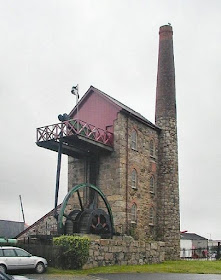This monster is an English 18th century mine pump. It is called Michell's Shaft Engine House, and it is the last beam engine to be installed in Cornwall. It has a cylinder of 30 inches (0.76 m) diameter and was built in 1887. It was designed to run at 27 strokes per minute. It is still run on occasion. The mine that it pumped out was 540 feet deep.
Totally cool cutaway of a locomotive boiler! The firebox is the big opening above left, and you can see where the hot gas goes through the tubes, which are surrounded by boiling water. The big brass bell up top is the steam dome, where the steam is separated from water and sent to the pistons to drive the locomotive.
This is kinda cool also. It's interesting how many linkages were needed in order to get the correct motion for timing the (upper) steam admission piston. If an engineer were to build a piston steam locomotive today, I wonder how it might be done. How would electronic engine controls, electrical or hydraulically operated valves, and other modern devices be used to improve the machine?I like the one above, mainly because the valve train is easier to understand :)
Above is a Uniflow engine. This was the last major innovation before the end of piston type steam engines. As you can see, the cylinder exhausts at the center. There is a reason this design is more efficient than the engines above. Steam cools down as it expands. Thus on each stroke of the machines above, at the far end of the stroke, steam would actually be cooling the cylinder down, right before hotter steam was admitted to push the piston in the opposite direction.
The big advantage of this design is that the temperature profile of the cylinder is consistent. Hot at either end, and less hot in the middle. Interestingly, the ends had to be machined smaller than the middle, because the higher temperatures at each end caused the cylinder to grow larger in diameter.






Can you tell me where the cut away model for that train engine is located? I would love to go see it. Are there any more photos of it? This is by far the best steam engine cutaway I've ever seen.
ReplyDeleteHi Charles,
ReplyDeleteSorry it took so long to realize someone had posted to the blog!!!
I found this photo in wikipedia following a google search of "steam engine cutaway". The caption for the photograph of this engine is:
Isle of Man Railway No. 3 "Pender", sectioned at the Museum of Science and Industry in Manchester.